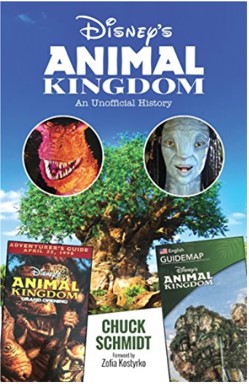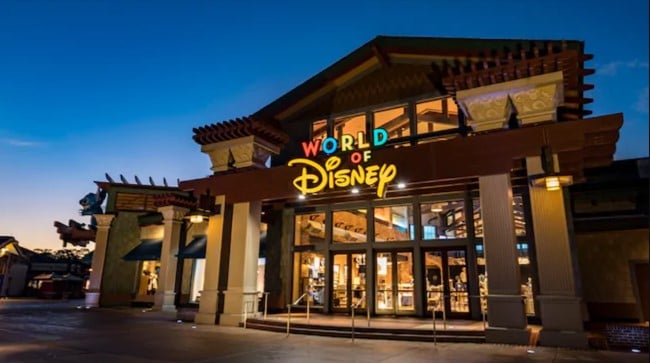Category — A Friday Visit with Jim Korkis
A Friday Visit with Jim Korkis: Disney’s Animal Kingdom–An Unofficial History
Welcome back to Fridays with Jim Korkis! Jim, the dean of Disney historians, writes about Walt Disney World history every Friday on yourfirstvisit.net.
YOUR PERSONAL DISNEY LIBRARY (15)
By Jim Korkis
- Disney’s Animal Kingdom: An Unofficial History by Chuck Schmidt
Other than The Making of Disney’s Animal Kingdom Theme Park by Melody Malmberg, released when the park first opened in 1998. and the later Imagineering Field Guide to Disney’s Animal Kingdom by Alex Wright (2007), there has been up to now no book solely devoted to Walt Disney World’s fourth theme park or the many significant changes that have occurred at it over the last decade and more.
Of course, there are other books that do include a section devoted to Disney’s Animal Kingdom, but this book is completely devoted to just the Animal Kingdom, and its coverage includes not only the park but also the Animal Kingdom Lodge, attractions never built, and also the recent Pandora: The World of Avatar expansion..
The book has sixteen chapters as well as a laudatory foreword by Zofia Kostyrko, an Imagineer who worked for years as part of the team that created and opened the park.
The book is very concise, with only 140 some pages devoted to the park plus an additional chapter of impressions of a variety of Disney fans who have visited it over the years.
Each section of the park, from Safari Village/Discovery Island to Camp Mickey-Minnie, is given its own chapter, and the book itself follows a loose chronological format from the beginnings of the project to its most recent additions.
Chuck Schmidt has been a newspaper journalist for decades and spent some of that time attending multiple Disney events including the opening of Disney’s Animal Kingdom. His media credentials also gave him access to talk with many of the Imagineers and others responsible for making the Disney dream a reality.
In fact, this book in particular benefits from contributions from Imagineers instrumental in the design and construction of Animal Kingdom, including Joe Rohde, Kevin Rafferty, Zofia Kostyrko (who had previously worked with Rohde on the Adventurers Club), and Marty Sklar (a final interview just a few weeks before he died). It also benefits from zoologist Rick Barongi and horticulturalist Paul Comstock, among others, who provide insights not available elsewhere.
For instance, Kostyrko revealed that inside the small temple that’s located near the entrance of Asia (by the Rivers of Light amphitheater), the original design team placed a time capsule, filled with sketches and other memorabilia from their years of work in shaping Animal Kingdom.
A long time Disney fan, Schmidt even has his own blog devoted to Disney, and has written three other books, including one on Disneyland Paris. His reporter training provides a clear, accurate presentation of what actually exists as well as occasional insights into the reason behind that existence.
I especially appreciated his sharing the influence the late Roy E. Disney had on the development of the park. In the book, Schmidt wrote: “During opening day ceremonies, Roy E. Disney said, ‘They [Walt & Roy] would have been thrilled with what has been created here and would have thought it a wonderfully appropriate addition to their company’.”
* * * * *
Thanks, Jim! And come back next Friday for more from Jim Korkis!
In the meantime, check out his books, including his latest, The Vault of Walt Volume 7: Christmas Edition, and his Secret Stories of Walt Disney World: Things You Never You Never Knew, which reprints much material first written for this site, all published by Theme Park Press.
Follow yourfirstvisit.net on Facebook or Twitter or Pinterest!!
March 8, 2019 No Comments
A Friday Visit with Jim Korkis: Medfield College
Welcome back to Fridays with Jim Korkis! Jim, the dean of Disney historians, writes about Walt Disney World history every Friday on yourfirstvisit.net.
MEDFIELD COLLEGE
By Jim Korkis
Unlike Disneyland, WDW is home to several references to Medfield College, a beloved part of Disney heritage.
Underneath the Main Street train station is a board listing the arrivals and departures of trains. One entry shows the arrival of a train from Medfield while another entry shows the departure of a train from Rutledge, home of Medfield’s traditional rival college.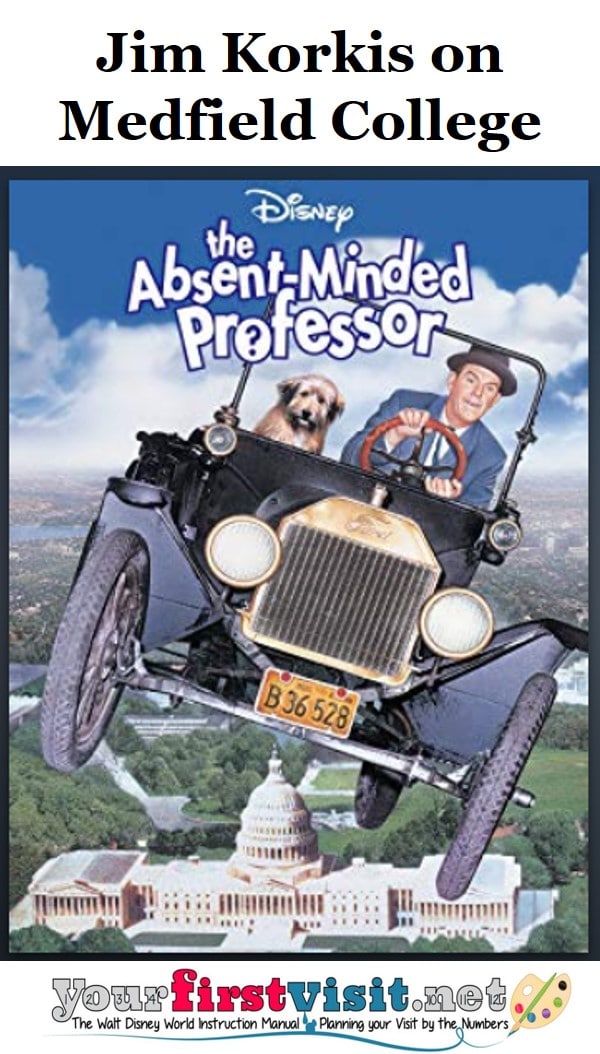
The town of Medfield where Medfield College is located is the setting for the Disney film The Shaggy D.A. (1976) which seems to imply that Medfield was also the location for The Shaggy Dog (1959).
Medfield College was named after the town of Medfield, Massachusetts. Before World War II, Walt Disney came to Medfield on several occasions to visit friend Justin Dart who began the Dart Drugstore chain. Dart lived on Holiday Farm on Elm Street.
Today’s soccer fields behind the Ralph Wheelock School back then contained his private dirt air-field where supposedly Walt would land a plane on these trips. It was on these visits that Walt Disney picked up the name “Medfield” as a nice collegial setting. The cornerstone of Blake Middle School (formerly Medfield High School) has a Walt Disney quote inscribed on it: “Our greatest natural resource is the minds of our children.”
The Medfield College scenes in both The Absent-Minded Professor and Son of Flubber were filmed on the campus of Pomona College in Claremont, California, as well at the Disney Studios in Burbank.
When Dexter Riley (Kurt Russell) and his friends gather outside the college’s administration building, they are at an outdoor patio near the entrance to the Disney Studios Animation Building. The only change was lettering placed by the entrance identifying it as a Science Building.
Since 1921, Pomona College has been used as an educational institution setting in dozens of feature films, television productions and commercials. Because of the overwhelming number of requests, Pomona’s policy now limits most location filming to periods when the College is not in session, and to projects that feature “significant involvement” by Pomona alumni, trustees, faculty, staff or students.
For the 2002 revamp of the Journey into Imagination attraction at Epcot, several visual references were included that suggested that the Imagination Institute had connections with Medfield College. In the queue line are several office doors. One is for Professor Brainard from the Absent Minded Professor films while another is for Dean Higgins, the role actor Joe Flynn played in the Dexter Riley films. In the first film in the series, when Higgins is looking out his meeting room window, he is looking at the same panoramic backdrop of the Walt Disney Studios in Burbank used for Walt’s filmed introductions to his television series.
In addition, the glass-fronted computer room has a sign on the door indicating “no tennis shoes allowed” referring to The Computer Wore Tennis Shoes movie, and the room also contains a Medfield College letterman’s jacket
By the way, the fight song of Medfield College which can be heard during the credit sequence of The Absent-Minded Professor was composed by Richard M. Sherman and Robert B. Sherman.
* * * * *
Thanks, Jim! And come back next Friday for more from Jim Korkis!
In the meantime, check out his books, including his latest, The Vault of Walt Volume 7: Christmas Edition, and his Secret Stories of Walt Disney World: Things You Never You Never Knew, which reprints much material first written for this site, all published by Theme Park Press.
Follow yourfirstvisit.net on Facebook or Twitter or Pinterest!!
March 1, 2019 No Comments
A Friday Visit with Jim Korkis: Two Disney Legends
Welcome back to Fridays with Jim Korkis! Jim, the dean of Disney historians, writes about Walt Disney World history every Friday on yourfirstvisit.net.
YOUR PERSONAL DISNEY LIBRARY (14)
By Jim Korkis
- From Jungle Cruise Skipper to Disney Legend by William “Sully” Sullivan
- From Disneyland’s Tom Sawyer to Disney Legend by Tom Nabbe
Both of these books were released in 2015 by Theme Park Press as part of their series of having Disney Legends share the stories of their Disney careers in their own words.
For historians, it is important and insightful to hear from the people who were actually there, although there is always the caveat that the recollections may be flawed. Their memories might be chronologically imprecise, or they may only have seen their part of the contribution to a project, or they may have an agenda to over promote what they did.
In the case of Walt Disney World, it is important to remember that it opened nearly fifty years ago and most of the people involved with that event are now at least eighty years old, or passed away, which makes it even more important to try and capture those personal first-hand accounts for a better understanding.
These are both short books, barely 125 pages each, and there are many unanswered questions that still need to be asked and documented of these two legends. However, what is in the books is very good stuff and has pretty much never appeared in print anywhere else before this publication. Great anecdotes, new revelations and interesting perspectives fill the pages, as well as putting some personalities to the names of others.
Both Tom and Sully started at Disneyland in 1955 so knew and worked with Walt Disney. Fifteen years later, when they moved to Florida to assist with the opening of Walt Disney World, they were seasoned veterans who were often assigned to help with problem solving at the new park.
Florida was a completely different world with an entirely different culture. Constant battles with bugs, heat and humidity, lack of supplies and lack of access to experienced labor resources were among the many other challenges. Neither man is shy about sharing the obstacles that confronted them while rushing to open Walt Disney World.
Tom was in charge of opening the Walt Disney World monorail system in 1971. He was the one who created the famous Nabbe Grabbers to reach down between the beams to recover items like hats, sunglasses, toys and more that guests dropped as they boarded or exited. Today, shorter versions are used by the WDW maintenance staff.
He ended up staying at WDW for the next 32 years and moving from the Monorail to one project after another. In 1972, he moved over to Frontierland during the construction of Tom Sawyer Island. They dragged out a bunch of old photos of him as a young Tom Sawyer at Disneyland in the 1950s for publicity. He later moved to Tomorrowland in 1973 for the building of Space Mountain and also a few other locations.
“Then I moved again to another project called EPCOT and in 1984 I finally made a key career change by going into Warehouse operations and that’s where I retired from in June of 2003,” said Tom.
“Sully” Sullivan came out in 1970 to train the cast who were going to work at the resorts in the Disney manner of how to do things. He was based at the Hilton Inn South off of International Drive. By the time, the Magic Kingdom opened in 1971, he was in charge of Security and Fire Prevention for Main Street, Adventureland, Frontierland, and Liberty Square. He was then transferred to the Resort Division, where he spent three and a half years, assisting and operating the Disney resort hotels.
Sully said, “I later had the opportunity to open and manage operations at Epcot Center. After operating Epcot Center for two years I went back to the Magic Kingdom as Vice President of the Magic Kingdom. And after thirty-nine and a half great years of working hard and playing hard at Disney, I decided to retire, which I did in February 1994.”
Each book covers memories of working at both Disneyland and Walt Disney World in the early years, and helps us to better understand why these two men truly deserved being made Disney Legends.
* * * * *
Thanks, Jim! And come back next Friday for more from Jim Korkis!
In the meantime, check out his books, including his latest, The Vault of Walt Volume 7: Christmas Edition, and his Secret Stories of Walt Disney World: Things You Never You Never Knew, which reprints much material first written for this site, all published by Theme Park Press.
Follow yourfirstvisit.net on Facebook or Twitter or Pinterest!!
February 22, 2019 No Comments
A Friday Visit with Jim Korkis: Disney’s Wilderness Lodge
Welcome back to Fridays with Jim Korkis! Jim, the dean of Disney historians, writes about Walt Disney World history every Friday on yourfirstvisit.net.
“NEW” OLD DISCOVERIES AT DISNEY’S WILDERNESS LODGE
By Jim Korkis
I have written on yourfirstvisit.net about the Wilderness Lodge several times [links to Jim’s earlier posts are at the bottom of the page–Dave], and revealed many of the “secrets” behind its details and storytelling. However, in November I did a presentation there for a group of amateur photographers, and when I went to explore the area in advance of that event, I stumbled across some other interesting things that I previously missed.
Outside, the Wilderness Lodge flies five flags just as does its inspiration, the Old Faithful Inn in Yellowstone. However, the flags at Wilderness Lodge have a Disney twist. Facing the building and looking left to right, the flags are the Wilderness Lodge flag, the Florida State flag, the American flag, the Disney Mickey Mouse flag and finally the Disney Vacation Club flag.
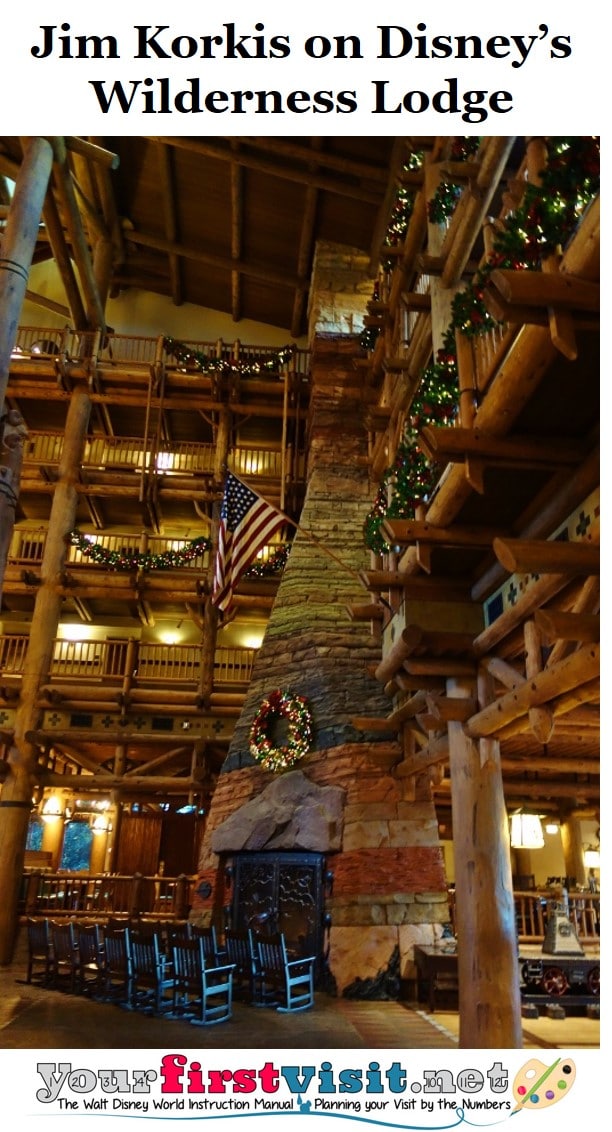
The Elk teeth are a sign of wealth and usually an indication that it was the property of a great hunter….because elk only have two teeth. This time I actually stopped to count the teeth. This particular dress has 161 teeth arranged in five almost even rows. Some rows have 32 while others have 31 or 33.
The Territory Lounge is devoted to the early explorers of the West, which is why on the ceiling is painted a map of the famous Lewis and Clark Expedition. In the glass cases are authentic artifacts from the 1800s. On the walls are a 34 star American flag from 1861 which explains why it is a bit tattered and an actual Wyoming State flag from 1890 that features an image of a white buffalo.
The paintings in the room are “inspired by Carl Clemens Runcius (1869-1959)”, a renowned wildlife artist who started painting animals in Wyoming in 1895.
I’ve written before about the totem poles in the lobby and shared the complete stories that are being told but I never stopped to read the plaques on the floor in front of both poles.
I have not found these short explanations recorded on the internet, nor any photos of the plaques. So in the interest of documenting things that haven’t been showcased, here are those descriptions:
“The Raven Pole (located next to the Whispering Canyon restaurant that these days is a lot quieter than it used to be), like all totem poles should be read from bottom to top. It includes Whale, Cougar, Wren, the bear cub twins, Dolphin and Salmon and culminates with the story of Raven pulling the sun, moon and stars from a box to light the darkened world. The figures on this pole are common to many tribes of the great Northwest.”
“The Eagle Pole, like all totem poles should be read from the bottom to the top. It includes Bear Chief, Frog, Bear Cub, Mountain Goat, Mouse Woman, Raven and Beaver. Eagle, who is a helper to all humans and animals perches on top. He is aided by three watchmen, known as Taan-skeel, who keep their eyes open day and night protecting the village. The figures on this pole are common to many tribes of the great Northwest.”
Of course, I love the Grand Canyon fireplace which was inspired by a much smaller real one at the Bright Angel Lodge at the Grand Canyon. Some Disney fans know that to the right of the fireplace is a display case that states:
“This 82’ tall pinnacle captures the color, lithographic proportions and fossil life found in the walls of the Grand Canyon. Follow the displays at each floor level to gain a greater insight into the Canyon’s formations and the history of life on earth. The fossils represented in these displays are not taken directly from the Grand Canyon but are of the same genera and therefore represent an accurate paleontological comparison.”
Thanks, Jim!
Here’s more of Jim’s posts on Disney’s Wilderness Lodge:
- Peter Dominick
- Treasures of the Wilderness Lodge
- The Fireplace of the Wilderness Lodge
- The Headdresses of the Wilderness Lodge
- Wilderness Lodge Sculptor William Robertson
- The Copper Creek Villas and Cabins
And come back next Friday for more from Jim Korkis!
In the meantime, check out his books, including his latest, The Vault of Walt Volume 7: Christmas Edition, and his Secret Stories of Walt Disney World: Things You Never You Never Knew, which reprints much material first written for this site, all published by Theme Park Press.
Follow yourfirstvisit.net on Facebook or Twitter or Pinterest!!
February 15, 2019 No Comments
A Friday Visit with Jim Korkis: Joe Rohde on the Animal Kingdom Difference
Welcome back to Fridays with Jim Korkis! Jim, the dean of Disney historians, writes about Walt Disney World history every Friday on yourfirstvisit.net.
JOE ROHDE ON THE ANIMAL KINGDOM DIFFERENCE
By Jim Korkis
On June 14, 1998, I got to attend a two hour presentation by Imagineer Joe Rohde, for the opening team roughly a week before Disney’s Animal Kingdom opened to the public, to explain to the team some of the differences between Disney’s Animal Kingdom and the other Disney theme parks.
“I’ll just give you one example. The first experience you have of Disney’s Animal Kingdom is our forecourt, before you enter the park; A profoundly geometric and humanly ordered space. We live surrounded by concrete, we control the forces of nature, we order everything, we have impact on that environment and that is that statement.
“And you walk through the gateway. And if you happen to look down as you do this, you will watch as you step off brushed concrete—which is just what any sidewalk looks like—and onto what appears to be dirt in a space of ten inches. And look in front of you and you will see nothing but jungle. You won’t see a road. You won’t see a path. You see nothing but jungle.
“Most of our theme parks play this game of reassurance…of letting you know and letting you understand very profoundly where you are. We don’t do that. We want you to have an adventure. You are supposed to be in a world of nature. Nature challenges you. We want you to have an adventure, so you walk into the park and look at the park and you don’t know where the hell you are or where you’re supposed to go.
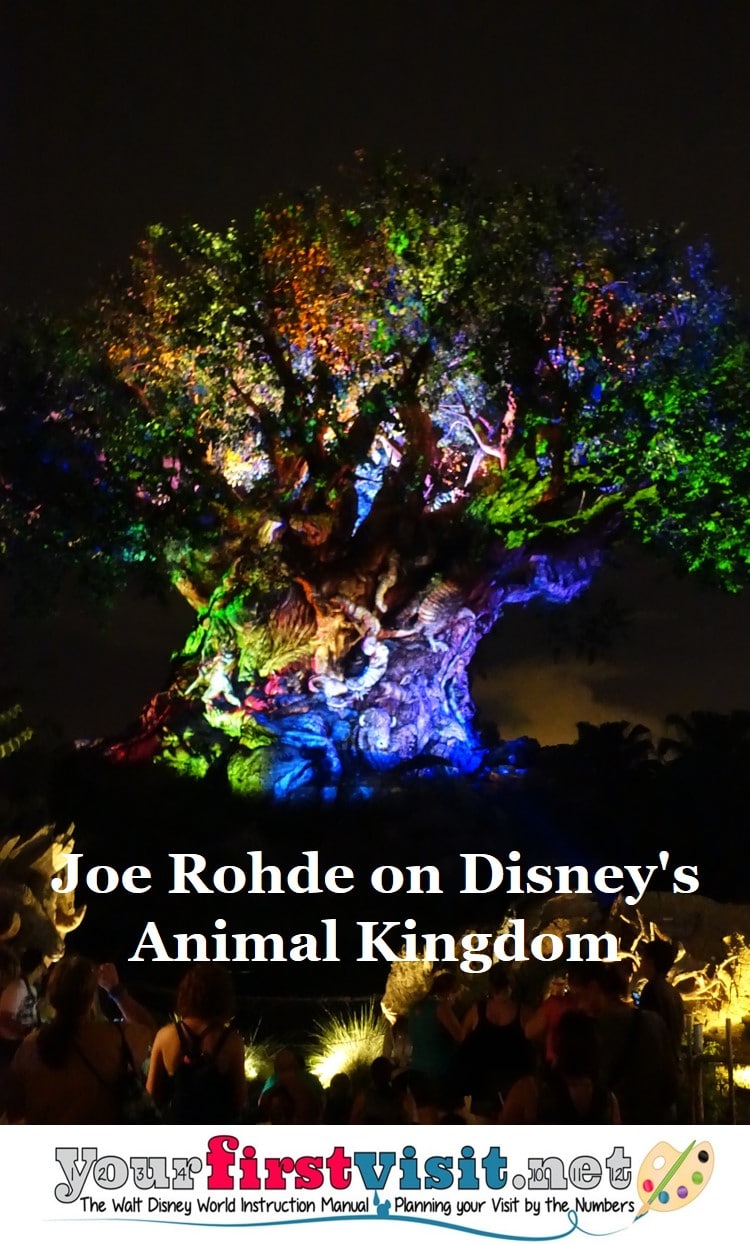
“Safari Village is the heart of this park. You’ll notice if you do go to DinoLand…if you go to Africa…someday you go to Asia…they all look like hell. They’re all sort of bio-degraded. They’re all weathered. They’re all aged. They’re all peeling. They’re all rotting. They’re all succumbing to the force of nature. They are all about a kind of futility in the force of nature.
“Safari Village is about the adoration of nature. And it is the only clean, pristine, beautiful, wonderful, colorful, rich, saturated area in the park. It is arranged around our tree—the axis of the park, the center of the park, the cathedral or our park rising up into the sky covered with these images like one of those Italian painted baroque church ceilings, right?
“And that is why it is so joyfully exuberant and colorful and rich in detail and saturated with animal imagery and that is why we established some of the design rules for it, which were: There will be no decoration unless it is animal decoration and there will be virtually no earth tones in the entire place. It is about all that intensity of fascination, obsession, and love.
“So, Safari Village is a very unique place. Safari Village is kind of a no place. There’s nowhere on Earth like Safari Village. It is meant, each time you cross through it on your way from somewhere to another place, to reorient you; to sort of clean your slate and set you up again for another adventure.
“Safari Village is not an adventure. It’s right there for you to see, right? It’s spread out in a nice clean circle around the tree. You get views of the other lands; that’s not the adventure. The adventure is across the bridge in all those different lands.
“Walk through the Magic Kingdom towards the castle, then hop in your vehicle, drive back to Animal Kingdom, and take the same journey. I think you’ll find that it is a profoundly different emotional experience.”
* * * * *
Thanks, Jim! And come back next Friday for more from Jim Korkis!
In the meantime, check out his books, including his latest, The Vault of Walt Volume 7: Christmas Edition, and his Secret Stories of Walt Disney World: Things You Never You Never Knew, which reprints much material first written for this site, all published by Theme Park Press.
Follow yourfirstvisit.net on Facebook or Twitter or Pinterest!!
February 8, 2019 No Comments
A Friday Visit with Jim Korkis: The World of Disney Store
Welcome back to Fridays with Jim Korkis! Jim, the dean of Disney historians, writes about Walt Disney World history every Friday on yourfirstvisit.net.
THE RE-IMAGINED WORLD OF DISNEY STORE IN DISNEY SPRINGS
By Jim Korkis
When the World of Disney store opened October 2, 1996 at Walt Disney World’s Downtown Disney (now Disney Springs), its first guests were given a colorful character map to help orient themselves to the massive 51,000 square feet of retail space referred to as “The Largest Disney Character Shop in the World.”
As Walt Disney World publicity described the World of Disney Store when it first opened: “It’s paradise for everyone, from the newest Mickey fan to the avid Disneyana enthusiast. Disney merchandise is arranged so artfully that this remarkable store is an attraction itself.”
However, time and operational needs change and so the World of Disney Stores both at Disneyland and Walt Disney World were recently transformed after more than a year of design and development. The Walt Disney World version opened October 27, 2018.
The official Disney press release stated that the “re-imagined World of Disney stores are being transformed into contemporary, distinctly Disney retail environments.”
“We saw World of Disney as an opportunity to re-imagine what Disney retail is today,” said Alysia Kelley, vice president of visual merchandising and location strategy for Walt Disney Parks and Resorts. “The new store design highlights the best of what is current and new, while also celebrating classic Disney heritage based in storytelling.”
The transformation begins with the store’s exterior, which features new marquees and magical window displays. All of the large-scale character sculptures were removed from both interior and exterior of the store, and the Disney-patterned wallpaper and carpeting was scrapped in favor of a style reminiscent of an Urban Outfitters or Gap store.
Both stores feature an interior “loft-style” atmosphere with greater visibility for all the displays and merchandise.
Of course, there is a back story for the new design.
Imagineering show writer Kevin Lively shared, “This space used to be a bus depot for the Grand California Tours which partnered with the Grand Californian hotel in Northern California to take people on local tours. The bus depot eventually shut down and in the 1940’s Walt was trying to find a new place to inspire his animators.
“He found a space in Disney Springs in Florida and in Northern California. He leased out the space for his animators to get away from the hustle and bustle of Los Angeles and Burbank and start working on what would be some of Disney’s most classic films. The animators worked in these warehouses for about 60 years, when in 1989 they decided to close them because they opened Disney-MGM Studios and had a dedicated animation space there.
“So these warehouses sat empty for years until they re-opened as the World of Disney as part of Downtown Disney. When it came time to fix up the stores this year for their rehab, they started taking down the drywall and these beautiful remnants of the past animation studio were revealed to the construction workers.
“Brick walls were revealed with forgotten signage for the bus depot. A wall of paint jars with some leftover magic had been previously drywalled over. And many sketches were unveiled. They used the Nine Old Men’s animator desks (that feature their sketches on the wood) to create the checkout space and the space is decorated with artwork, animation cels and hand drawn details from Disney’s body of work through 1989 when they were originally shut down.?
The space is still filled with nods to both the bus terminal and the animation studio, with a sign advertising bus tours painted above one archway in California and another indicating an Animation Annex in Florida as well as cash register areas created from reused Animation desks.
Animated displays, digital signs, video screens and special lighting effects are used throughout the store to make it easier to refresh the décor. The World of Disney remains an anchor location at Disney Springs and still reputedly offers the largest collection of Disney-themed merchandise in the world.
* * * * *
Thanks, Jim! And come back next Friday for more from Jim Korkis!
In the meantime, check out his books, including his latest, The Vault of Walt Volume 7: Christmas Edition, and his Secret Stories of Walt Disney World: Things You Never You Never Knew, which reprints much material first written for this site, all published by Theme Park Press.
Follow yourfirstvisit.net on Facebook or Twitter or Pinterest!!
February 1, 2019 No Comments

